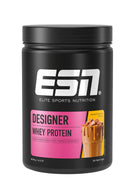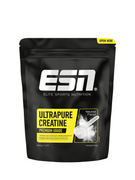Hardgainer und ihre besonderen Voraussetzungen fürs Training
Vielleicht bist du ja auch selber von dem Problem eines schwierigen Muskelaufbaus betroffen oder ordnest dich sogar selbst der Kategorie Hardgainer zu – dann ist unser Ratgeberartikel genau das Richtige für dich! Wir helfen dir dabei, deinen Hardgainer-Trainingsplan zu erstellen.
Der Begriff Hardgainer wird in der Fitness-Community voreilig für all diejenigen verwendet, denen es trotz Training und vermeintlich gesunder Ernährung offensichtlich schwerfällt, an Muskelmasse zuzulegen. Bei der Einteilung der drei Körper- bzw. Stoffwechseltypen von William Sheldon ging es im Jahre 1930 aber um viel mehr als das. Der ektomorphe Körpertyp (Hardgainer) zeichnet sich optisch in der Regel durch besondere Auffälligkeiten von den anderen Typen ab: Hardgainer sind groß und besonders schmal, verfügen über einen kurzen Oberkörper, schmale Schultern und Hüften und nicht zuletzt zierliche Hände und Füße, während Arme und Beine verhältnismäßig lang sind. Auch der Stoffwechsel unterscheidet sich von denen der anderen Körpertypen – er ist deutlich erhöht, wodurch der Organismus eine ineffiziente Nährstoff- und Energieverwertung aufweist. Am Ende eines Tages verbleiben den Hardgainern im Normalfall nur wenige bis gar keine Nährstoffe, die als Muskeln oder Fettdepots angelegt werden können. Daraus schließt sich, dass die meisten Personen dieses Körpertyps über einen sehr geringen Körperfettanteil verfügen.
In einem anderen Beitrag haben wir dich schon ausführlich über das Thema Hardgainer informiert. Im Folgenden werden wir auf Basis der bestehenden besonderen Voraussetzungen des ektomorphen Körpertypen auf die Notwendigkeiten im Krafttraining eingehen und aufzeigen, dass es trotz aller Gegebenheiten möglich ist, Muskulatur aufzubauen – du benötigst nur einen passenden Trainingsplan für Hardgainer.

Grundsätze des Krafttrainings und der Muskelhypertrophie – dieselbe Basis für alle Körpertypen
Unter Muskelhypertrophie wird die Zunahme und das Wachstum von Muskelzellen verstanden. Erreichbar ist sie in erster Linie durch Krafttraining, das mit schweren Gewichten absolviert wird. Vielleicht hast du dich schon einmal gefragt, welche Übungsausführung für deinen Muskelaufbau eigentlich am sinnvollsten ist, denn oft wird bei der Anmeldung in einem Fitnessstudio die Empfehlung geäußert, je drei Sätze mit jeweils 15 Wiederholungen auszuführen. So pauschal gilt das allerdings nicht für jeden, denn sowohl das Trainingsgewicht, die Anzahl an Übungen je Training, die Anzahl an Wiederholungen je Übung als auch die Anzahl an Trainingstagen pro Woche sind – je nach Körpertyp und sportlichem Ziel – vollkommen individuell.
Durch schweres Krafttraining fügst du deiner Muskulatur kleine mechanische Schäden zu und lässt sie metabolisch ermüden. Die strukturellen Schäden stimulieren die Reparaturfunktion des Organismus, sodass die dafür benötigten Proteine eine Zunahme der Muskelgröße sicherstellen, um für das nächste Training „vorbereitet“ zu sein – der Körper versucht somit alles, sich an die Gegebenheiten und vermutlich bevorstehenden Herausforderungen bestmöglich anzupassen. Klingt zunächst simpel und vor allem zuvorkommend vom eigenen Körper, doch so schnell geht das alles leider natürlich nicht. Es bedarf einiger Trainings und vor allem auch einer zielorientierten, ausgewogenen Ernährung. Für die richtige Ernährung haben wir einen eigenen Beitrag zum Thema Hardgainer Ernährungsplan erstellt.
Die wichtigste Aussage hast du wahrscheinlich bereits erkannt: Auch für dich – als ektomorpher Typ – ist es möglich, an Muskelmasse zu gewinnen. Dem Thema, wie ein Kraftsportler richtig und vor allem möglichst fettfrei Masse aufbauen kann, haben wir uns bereits in einem anderen Artikel gewidmet.
Die Skelettmuskulatur eines Hardgainers ist tendenziell in Form dünner Muskelschläuche angelegt. Die Muskeln weisen dadurch eine eher längliche Fläche und weniger Volumen auf. Grundsätzlich verfügt der ektomorphe Körpertyp auch über mehr ST-Fasern, während für eine Muskelhypertrophie und somit ein voluminöses Wachstum primär FT-Fasern benötigt werden. Die ST-Fasern sind besonders gut für Ausdauereinheiten. Doch es ist ein Irrglaube, nun davon auszugehen, dass demnach im Fitnessstudio Kraftausdauer trainiert werden sollte, um ein Muskelwachstum sicherzustellen. Der Hardgainer ist insbesondere aufgrund dieser Tatsache dazu angehalten, noch härteres Hypertrophie-Training durchzuführen. Du erkennst: Ein spezifischer Hardgainer-Trainingsplan sollte dir eine Herzensangelegenheit sein.
Wiederholungskontinuum, Gewicht, Trainingsstruktur – Trainingsplan für Hardgainer
Damit du erfolgreich Masse aufbauen kannst, solltest du dir einen spezifischen Trainingsplan für Hardgainer mit den folglich beschriebenen Empfehlungen aufstellen:
Trainingsstruktur und Trainingsgewicht
Erstelle dir im ersten Schritt einen Trainingsplan für Hardgainer, der ausschließlich aus Ganzkörpertrainingseinheiten besteht und drei Mal pro Woche durchführbar ist. Eine Idee für etwas Abwechslung wäre, gleich zwei Trainingstage durchzuplanen und diese im Wechsel durchzuführen. Aufgrund deiner erhöhten Stoffwechselrate sollte eine Trainingseinheit „nur“ eine Dauer von 45 bis maximal 60 Minuten aufweisen, da du deine Muskeln zwar reizen, aber keinesfalls ins Übertraining rutschen solltest. Jede weitere Minute der intensiven Bewegungen bedeutet auch weitere verbrannte Kalorien, die du über die Ernährung wieder einholen musst.
Zwischen deinen Trainingstagen sollten ein bis zwei Tage Pause liegen, damit sich dein Körper ausreichend erholen kann. Ruhe ist ein weit unterschätztes Kriterium, denn die meisten wissen gar nicht, dass die Muskeln nicht während des Trainings, sondern in der Zeit der Regeneration wachsen – du solltest daher unbedingt sicherstellen, dass dein Körper die Phase der Superkompensation erreicht. Unterstützen kannst du den Regenerationsprozess beispielsweise durch viel Schlaf, wenig Stress oder Saunagänge.
Damit du aus deiner Trainingseinheit möglichst viel für deinen Körper herausholen kannst, solltest du verstärkt auf funktionelle Grundübungen und weniger auf isolierte Übungen zurückgreifen. Auch wenn es derweil Geräte gibt, die funktionelle Grundübungen unterstützen, solltest du dich eher an die freien Gewichte wagen, wenn du die Übungen bereits sauber ausführen kannst. So müssen deine Muskeln mehr ausgleichen und arbeiten, wodurch sie logischer Weise besser gereizt werden. Führe von einer Übung ruhig vier bis fünf Sätze durch und steigere das Gewicht nicht nur von Training zu Training, sondern auch von Satz zu Satz kontinuierlich, um immer wieder neue, intensivere Reize zu setzen.
Also:
- Trainingseinheiten von 45 - 60 Minuten
- Ein bis zwei Tage Pause zwischen den Trainingseinheiten
- Wenn möglich: Freie Gewichte nutze (nur bei sauberer Ausführung!)
- 4 - 5 Sätze pro Übung mit kontinuierlicher Gewichtsteigerung
Wiederholungskontinuum
Die Anzahl der Wiederholungen, die du ausführst, kann ausschlaggebend für dein Muskelwachstum sein und sollte daher in deinem Trainingsplan für Hardgainer berücksichtigt werden. Am besten orientierst du dich für eine zu erreichende Muskelhypertrophie an einer Wiederholungszahl von sechs bis zwölf. In der Regel führen weniger Wiederholungen zu einer Entwicklung von mehr Muskelkraft und mehr als zwölf Wiederholungen zu einer Entwicklung von mehr Muskelausdauer. Wie bei vielen Modellen sind das natürlich nur Richtwerte. Du solltest hier unbedingt austesten, welche Anzahl an Wiederholungen deine Muskeln besonders reizt, aber – entgegen der anderen Körpertypen – nicht bis zum Muskelversagen führt, da dieses deinen Stoffwechsel noch mehr antreibt und für deinen Körper somit eher kontraproduktiv ist. Eine Übungsdurchführung von mehr als 20 Wiederholungen macht allerdings in keiner Weise Sinn. In dem Fall handelt es sich nicht mehr um mäßiges bis schweres Krafttraining, sodass auch keine Hypertrophie zustande kommen kann. Zwischen deinen Sätzen solltest du 90 bis 120 Sekunden Pause einlegen, damit du möglichst viel Energie zurückgewinnst.
Also:
- Als Faustregel: 6 - 12 Wiederholungen
- Testen, welche Wiederholungsanzahl deine Muskeln besonders reizt, aber nicht bis zum Muskelversagen
- 90 - 120 Sekunden Pause zwischen den Sätzen
Cardiotraining
Auch wenn dein Körper mit der Veranlagung von verhältnismäßig vielen ST-Fasern gut auf Cardio-Einheiten ausgerichtet ist, solltest du dich damit – zumindest in Bezug auf dein Trainingsziel des Muskelaufbaus – möglichst zurückhalten. Wenn du es aufgrund der Vorzüge für unser Herz-Kreislauf-System gerne durchführen möchtest, solltest du es auf einmal pro Woche für 30 Minuten mit einer lockeren Intensität beschränken. Da du durch dein Krafttraining schon ordentlich Kalorien verbrennst und deine Muskeln intensiv reizt, solltest du die Cardioeinheit jedoch keinesfalls am selben Tag, sondern separat an einem deiner Ruhetage durchführen. Plane das Cardiotraining bewusst in deinen Trainingsplan für Hardgainer ein, damit du die verbrauchte Leistungsenergie auch in deinem Ernährungsplan berücksichtigen kannst.
Also:
- Cardiotraining nur 1x pro Woche für 30 Minuten bei niedriger Intensität
- Cardiotraining an einem deiner Ruhetage - nicht an Trainingstagen - durchführen
- Verbrauchte Energie bei der Ernährung berücksichtigen
Ausgewogene Ernährung und ergänzende Supplements für deinen Trainingsplan
Eine Faustformel besagt, dass sich die Erreichung der körperlichen Ziele aus 30 % erfolgreichem Training und 70 % gezielter Ernährung zusammensetzt. Gerade bei dir als Hardgainer ist eine spezifische, zielorientierte Ernährung wichtig, damit du deinem Körper genügend Nährstoffe, die er ineffizient verarbeitet, zur Verfügung stellen kannst. Auch wenn die Tatsache, dass du essen kannst, was du willst, ohne zuzunehmen, ein Luxusproblem für andere darstellt, ist es für dich verständlicher Weise die größte Strafe und hier entsteht auch das erste Risiko: Um dein Kalorienziel zu erreichen, solltest du keinesfalls auf Süßkram und Junk-Food zurückgreifen. Viel wichtiger ist eine ausgewogene, gesunde Ernährung, die dich mit wichtigen Makro- und Mikronährstoffen versorgt.
Wie alle anderen (Kraft-)Sportler auch, kannst du über Supplements ein wenig nachhelfen. Selbstverständlich sollen sie keine deiner Mahlzeiten ersetzen, doch gerade wenn es um die Erreichung deines Proteinbedarfs oder die Sicherstellung eines Kalorienüberschusses geht, können sie sehr hilfreich sein.

Damit du bei deinem Krafttraining die maximalen Kräfte aus dir rausholen kannst und du dich nicht länger unterschätzt, kannst du es einmal mit einem Pre-Workout Booster, wie unserem ESN CRANK, probieren.
Orientierung für deinen Trainingsplan als Hardgainer
Stellst du dir einen Hardgainer-Trainingsplan für den Anfang zusammen und achtest darauf, funktionelle Grundübungen zu verwenden, könnte deine Übungszusammensetzung folgendermaßen aussehen:
| Übung | Sätze | Wiederholungen |
| Bankdrücken | 3 - 5 | 6 - 12 |
| Kniebeuge | 3 - 5 | 6 - 12 |
| Klimmzüge | 3 - 5 | 6 - 12 |
| Schulterdrücken | 3 - 5 | 6 - 12 |
| Kreuzheben | 3 - 5 | 6 - 12 |
| Langhantelrudern | 3 - 5 | 6 - 12 |
Es ist schwierig, einen Trainingsplan pauschal zu erstellen, daher sollte dir die vorherige Aufstellung nur als Orientierung dienen. Hör am besten auf deinen Körper, wie viele Sätze du pro Übung tatsächlich durchführen kannst und, ob du in der Zeit von 45 bis 60 Minuten mit deinem Training durchkommst. Benötigte Pausen und die Zeit für die Übungsausführung sind individuell. Wichtig ist, dass du dein persönliches Wiederholungskontinuum für einen gezielten Muskelaufbau findest und in jedem Ganzkörpertraining auch jede Muskulatur ein Stück reizt, da nur so ein Wachstum sichergestellt werden kann. Gib dem Ganzen ein wenig Zeit und du wirst merken, dass dir dein Körper auf seine ganz eigene Art und Weise Feedback gibt.
Muskelaufbau für Hardgainer – ein Weg mit viel Geduld
Wie du im Laufe des Artikels gemerkt hast, ist der Muskelaufbau für dich als Hardgainer kein Hexenwerk. Auch, wenn du über andere natürliche Voraussetzungen verfügst und daher vor anderen Herausforderungen stehst als andere Sportler, funktioniert der Muskelaufbau dennoch nach denselben Prinzipien, auf die du Acht geben solltest.
Der Weg wird steinig und daher nicht immer einfach, aber mit genügend Disziplin und Geduld wirst du in einigen Monaten über eine ästhetische Skelettmuskulatur verfügen. Denke immer daran, wofür du es tust und bleib dran, deinen Trainingsplan für Hardgainer durchzuziehen!









